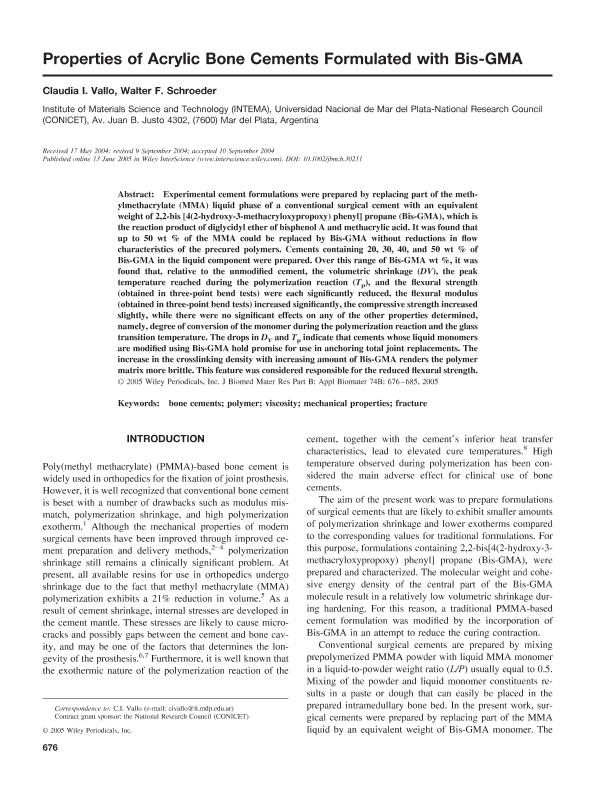Mostrar el registro sencillo del ítem
dc.contributor.author
Vallo, Claudia Ines

dc.contributor.author
Schroeder, Walter Fabian

dc.date.available
2017-11-10T20:55:18Z
dc.date.issued
2005-06-13
dc.identifier.citation
Vallo, Claudia Ines; Schroeder, Walter Fabian; Properties of acrylic bone cements formulated with Bis-GMA; Wiley; Journal Of Biomedical Materials Research; 74B; 2; 13-6-2005; 676-685
dc.identifier.issn
0021-9304
dc.identifier.uri
http://hdl.handle.net/11336/27977
dc.description.abstract
Experimental cement formulations were prepared by replacing part of the methylmethacrylate (MMA) liquid phase of a conventional surgical cement with an equivalent weight of 2,2-bis [4(2-hydroxy-3-methacryloxypropoxy) phenyl] propane (Bis-GMA), which is the reaction product of diglycidyl ether of bisphenol A and methacrylic acid. It was found that up to 50 wt % of the MMA could be replaced by Bis-GMA without reductions in flow characteristics of the precured polymers. Cements containing 20, 30, 40, and 50 wt % of Bis-GMA in the liquid component were prepared. Over this range of Bis-GMA wt %, it was found that, relative to the unmodified cement, the volumetric shrinkage (DV), the peak temperature reached during the polymerization reaction (Tp), and the flexural strength (obtained in three-point bend tests) were each significantly reduced, the flexural modulus (obtained in three-point bend tests) increased significantly, the compressive strength increased slightly, while there were no significant effects on any of the other properties determined, namely, degree of conversion of the monomer during the polymerization reaction and the glass transition temperature. The drops in DV and Tp indicate that cements whose liquid monomers are modified using Bis-GMA hold promise for use in anchoring total joint replacements. The increase in the crosslinking density with increasing amount of Bis-GMA renders the polymer matrix more brittle. This feature was considered responsible for the reduced flexural strength.
dc.format
application/pdf
dc.language.iso
eng
dc.publisher
Wiley

dc.rights
info:eu-repo/semantics/openAccess
dc.rights.uri
https://creativecommons.org/licenses/by-nc-sa/2.5/ar/
dc.subject
Bone Cements
dc.subject
Polymer
dc.subject
Viscosity
dc.subject
Mechanical Properties
dc.subject
Fracture
dc.subject.classification
Físico-Química, Ciencia de los Polímeros, Electroquímica

dc.subject.classification
Ciencias Químicas

dc.subject.classification
CIENCIAS NATURALES Y EXACTAS

dc.subject.classification
Recubrimientos y Películas

dc.subject.classification
Ingeniería de los Materiales

dc.subject.classification
INGENIERÍAS Y TECNOLOGÍAS

dc.title
Properties of acrylic bone cements formulated with Bis-GMA
dc.type
info:eu-repo/semantics/article
dc.type
info:ar-repo/semantics/artículo
dc.type
info:eu-repo/semantics/publishedVersion
dc.date.updated
2017-11-03T19:57:30Z
dc.journal.volume
74B
dc.journal.number
2
dc.journal.pagination
676-685
dc.journal.pais
Estados Unidos

dc.journal.ciudad
Hoboken
dc.description.fil
Fil: Vallo, Claudia Ines. Consejo Nacional de Investigaciones Científicas y Técnicas. Centro Científico Tecnológico Conicet - Mar del Plata. Instituto de Investigaciones en Ciencia y Tecnología de Materiales. Universidad Nacional de Mar del Plata. Facultad de Ingeniería. Instituto de Investigaciones en Ciencia y Tecnología de Materiales; Argentina
dc.description.fil
Fil: Schroeder, Walter Fabian. Consejo Nacional de Investigaciones Científicas y Técnicas. Centro Científico Tecnológico Conicet - Mar del Plata. Instituto de Investigaciones en Ciencia y Tecnología de Materiales. Universidad Nacional de Mar del Plata. Facultad de Ingeniería. Instituto de Investigaciones en Ciencia y Tecnología de Materiales; Argentina
dc.journal.title
Journal Of Biomedical Materials Research

dc.relation.alternativeid
info:eu-repo/semantics/altIdentifier/doi/http://dx.doi.org/10.1002/jbm.b.30211
dc.relation.alternativeid
info:eu-repo/semantics/altIdentifier/url/http://onlinelibrary.wiley.com/doi/10.1002/jbm.b.30211/abstract
Archivos asociados
